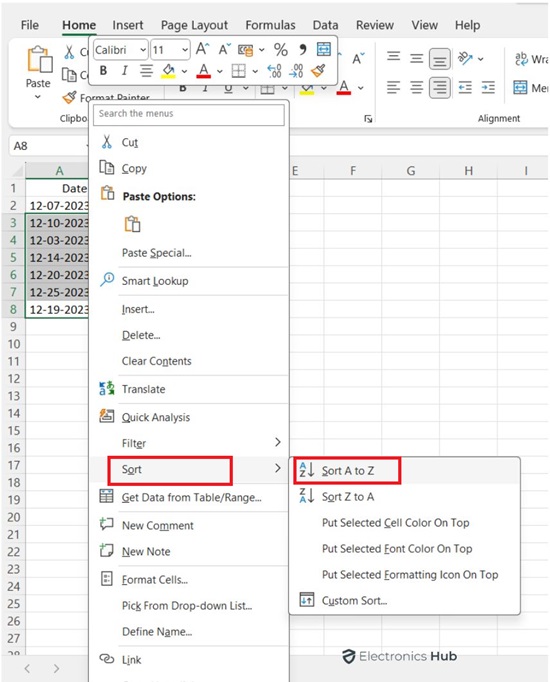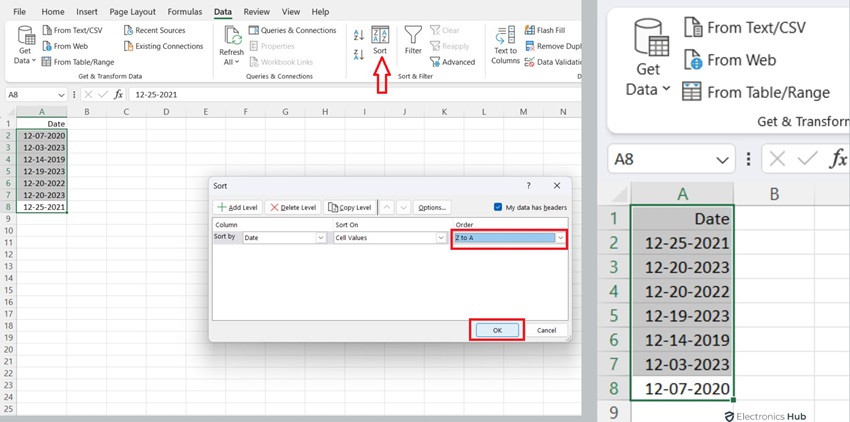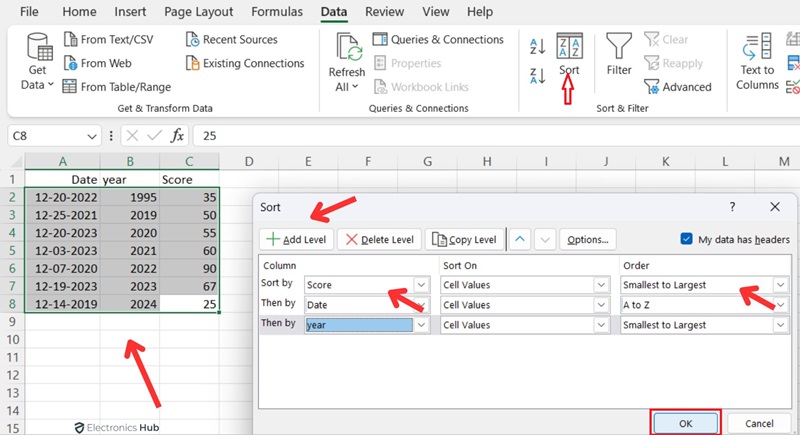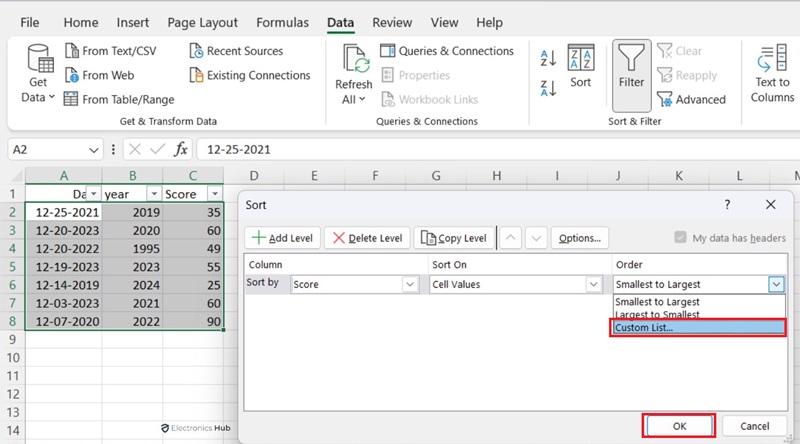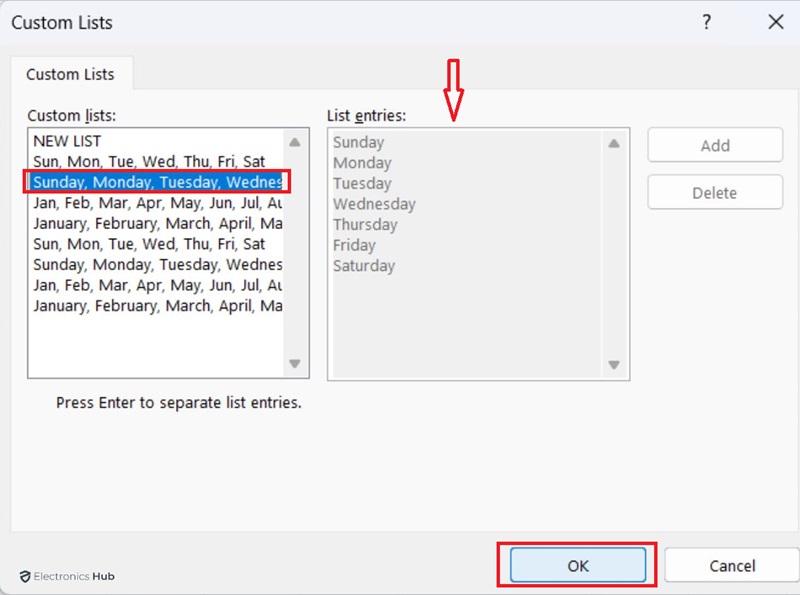Microsoft Excel is the most advanced data handling software with highly enhanced data management, which makes it the ideal choice for professionals and businesses to manage and sort large amounts of data. Excel can also create different types of charts and tables, such as pie charts, bar graphs, etc, to display data in a visual form.
This helps users to understand the data better and to identify patterns and outliers. In this guide, we will be explaining the data sorting feature in MS Excel and how you can use it efficiently. Apart from that, we will also guide you with some helpful tips regarding sorting by date and dive into some advanced solutions for the same. So, make sure you follow our guide until the end.
Outline
ToggleWhat Is The Sort by Date Feature in MS Excel?
One of the most gracious features of Excel is the data sorting feature. It allows users to arrange data in a logical and meaningful order, such as alphabetical, numerical, chronological, or even by custom priority. So, it helps users to quickly visualize and understand their data better, organize and find the data that they want, and ultimately make more effective decisions.
One of the best ways to organize the data in Excel is by sorting the data based on date, especially when you are designing the spreadsheet to update dynamically using VBA. date sorting can be performed in various ways such as ascending date, descending date, via a particular day, month, or year in the date string, or even selective dates throughout the sheet. So, with date sorting, you can keep track of when the data was entered in the sheet and track the updates with ease.
Benefits of Sort by Date in MS Excel
Sorting by date also helps to see the trends and patterns in their data over time, such as sales growth, seasonal fluctuations, progress over time, etc. Users can also compare the data across different periods such as yearly quarters or years and identify the best performing periods.
Sorting by date can help users prioritize and manage their tasks and deadlines, such as invoices, orders, or appointments. More importantly, users filter the data by date to focus on the most urgent or relevant tasks and avoid missing any important deadlines.
Lastly, sorting the data entries by date can help users create and update reports or a dashboard that displays the data in a visual form. You can provide conditional formatting on top of the sorted data to perform additional data validation and analysis tools to enhance the presentation and quality of the data.
Is It Possible To Identify Dates in MS Excel Data?
Yes, it is possible to identify dates specifically in the amalgamation of MS Excel data. Excel stores dates as serial numbers which simply are the number of days that have passed since January 1, 1900. So, it works as a reference to track the time and manipulate the date strings as you want. For instance, the date January 5th, 2023 is stored as 44552, which means 44,552 days have elapsed since the beginning of the 20th century. Excel can also recognize and format dates based on the system settings or user preferences.
How To Sort By Date in MS Excel?
Now, let’s move on to various methods available in MS Excel that let users sort the data by date based on their requirements. You can use any of the methods mentioned below as all of the methods covered in the guide are supported by all versions of MS Excel. So whether you are familiar with an older but popular option such as Excel 2007, or using the latest version bundled with the Microsoft 365 service, you will be able to use these methods. We will also explain the methods in detail so that you can use these solutions to sort any type of data without any problem.
Using Sort by Date for a Single Column
If you want to sort a single column that contains only dates, you can use the following steps:
- Select the column that contains the dates you want to sort.
- Under the Data tab, you will find the Sort & Filter group.
- This group gives you multiple options to sort your selected data.
- For a simple sort operation, you can either click Sort Oldest to Newest or Sort Newest to Oldest, depending on your requirement.
- You might get asked if you want to expand your selection to the other columns too or continue with the current selection.
- Since you only want to sort the selected column, click on the second option.
- Click the Sort button. Your selected column will be sorted from the oldest to newest or newest to oldest date, according to the option you selected.
Alternatively, if you want to sort dates based on month or year, you can use the following steps:
- Select the column that contains the dates.
- Click the Sort button from the Data tab.
- Make sure the Value option is selected for the second drop-down list in excel. For the third drop-down list, select the order in which you want to sort your dates.
- In the Sort Options dialog box, select the Month or Year option from the Date drop-down list. This will sort your dates by month or year, regardless of the day.
- Click OK to close the Sort Options dialog box. Click OK again to close the Sort dialog box and apply the sorting.
Using Sort by Date for Multiple Columns
If you want to sort multiple columns by date, you can use the following steps:
- Select all the cells that you want to sort.
- Open the Sort dialog box by following the instructions mentioned previously.
- In the Sort dialog box, select the column containing your dates from the first drop-down list.
- If you want to sort by multiple criteria, including date, you can click the Add Level button. This will add another row of drop-down lists, where you can select another column and sorting order.
- You can add as many levels as you need, and change the priority of each level by using the arrows on the left.
- Click OK to close the box and apply the changes.
Using Sort by Date with Custom Settings
In many cases, users need to apply custom logic to sort the data such as skipping public holidays or weekends from the selection. For that, you will have to specify your requirements using custom settings while using the sort by date feature. While it may appear a bit complicated, you will surely get used to the future once you use it a couple of times. And since you are dealing with custom settings while managing and sorting the data by date, the steps get even easier.
Creating Custom Sorting Orders
If you want to sort your dates in a specific order that is not available in the default options, you can create your own custom sorting order. For example, you can create a list of seasons, such as Spring, Summer, Fall, Winter, Year, Score and use it to sort your dates.
- To create a custom list, go to the File tab and click Options.
- In the Excel Options dialog box, click the Advanced category and scroll down to the General section.
- Click the Edit Custom Lists button. This will open the Custom Lists dialog box.
- Within this dialog box, you can type your list items in the List entries box, separated by commas or paragraphs.
- Click the Add button to add your list to the Custom Lists box.
- Click OK to close the Custom Lists dialog box.
- Click OK again to close the Excel Options dialog box.
Sorting by Date using Formulae
Sorting by date in Excel can be done using various formulas, depending on your needs and preferences. Here are some examples of how to use formulas to sort by date:
To sort dates in ascending or descending order, you can use the SORT function directly. This function sorts an array of values based on one or more criteria.
Example – SORT(A2:A20,1)
The first argument in this formula is the range of dates whereas the second argument is kept blank because we don’t have any other criteria, and the third argument is 1, which means ascending order. If you want to sort the dates in reverse order, you can use -1 instead of 1.
To sort dates by month or year instead of day, you can use the MONTH or YEAR functions. These functions extract the month or year number from a date, which you can then use as a criterion for the SORT function.
Example – SORT(A2:A20,MONTH(A2:A20),1)
Here, the first argument is the range of dates like before and the second argument is the month numbers extracted from the dates. If you want to sort the dates by year, you can use the YEAR function instead of the MONTH function and it will perform the same action based on the year.
To sort dates by multiple different criteria at the same time, you can use the TEXT function. This function converts a value to text in the specified format.
Example – SORT(A2:A20,TEXT(A2:A20,“MMDD”),1)
Similar to other examples, the first argument represents the range of dates and the second argument is the text format of the dates which is MMDD for month and day. You can modify the formula for different formats of the TEXT function such as YYYYMMDD for year, month, and day, or DDM on for day and month names.
Common Problems Regarding Sort by Date
One of the most common problems is that your dates are not recognized as dates by Excel, but as text. This can happen if your dates are in an unrecognized format, such as dd/mm/yyyy instead of mm/dd/yyyy, or if they have extra spaces or characters. To fix this problem, you can use the Format Cells option to change the cell format to Date, or use the Text to Columns feature to convert your text to dates directly.
Another common problem is that you do not select the entire range of data that you want to sort, or you select more than you need accidentally. This can cause either some of your data to be left out of the sorting or to be mixed up with other data. To fix this problem, you can use the Ctrl + A shortcut to select all the data in your worksheet or use the Ctrl + Shift + arrow keys to select the data in your column or row. You can also use the Sort dialog box to specify the range of data that you want to sort.
Lastly, you may miss out on using the custom sort options that are available in Excel, such as creating your own custom list to sort your dates. This can limit your ability to sort your dates in a specific or complex way, such as by seasons, quarters, or weekdays. To fix this problem, you can use the Custom Lists option to create your own list of values that you want to sort by such as Mon, Tue, Wed, etc. You can also use formulas to sort your dates as we mentioned in this guide by using the date values with DATE, DATEVALUE, MONTH, YEAR, or TEXT functions.
Helpful Tips While Sorting Your Data in MS Excel
Maintaining sorted data over time is important for ensuring data accuracy, consistency, and usability. Here are some bullet points for best practices for maintaining your spreadsheet:
- Use a centralized database to store and organize data in one place, and avoid data duplication and fragmentation.
- Use consistent and standardized data formats, such as date, time, currency, etc., and avoid ambiguous data entries.
- Use appropriate sorting algorithms and methods, such as insertion sort or bubble sort for previously sorted data.
- Use multiple criteria and levels for sorting data, such as by date, month, year, priority, etc., and use custom lists or formulas to sort data in a specific manner.
- Use the Sort & Filter tool in Excel to easily sort or filter data by date or other criteria.
- Use data validation and error-checking tools to ensure data quality and accuracy at all times.
- Use data analysis and reporting tools to visualize and understand data trends and patterns.
- Update and refresh data regularly to reflect the latest changes and additions
- Use automation and scheduling tools to perform data sorting tasks periodically or on demand.
- Review and evaluate data sorting results and performance, and use feedback and metrics to improve data management processes and outcomes.
Also Check: How To Move (Swap) Columns In Excel?
FAQs
Ans: There are several possible reasons why MS Excel might not allow sorting by date. In many cases, your dates might be formatted as text instead of date values. In such a case, Excel cannot sort text values in chronological order unless they are in a specific format, such as yyyy-mm-dd. It is also possible that you may not have selected the entire range of data that you want to sort. This can cause some of your data to be excluded from the sorting process. It can also happen because of choosing the wrong order for sorting your dates, such as ascending instead of descending, or by day instead of month or year.
Ans: Yes, it is possible to sort by date and time simultaneously in MS Excel. For that, you can use the custom sort option to sort your data by multiple criteria, including date and time.
* First, select both columns of data that have the Date and Time.
* Under the Home tab, click Sort & Filter and choose Custom Sort from the dropdown.
* In the Sort dialog box, make sure the My data has headers box is checked.
* In the Sort by box, select the Date column.
* Click the Add Level button to add another criterion.
* In the Then by box, select the Time column.
* In the Order box, select Smallest to Largest or Largest to Smallest, depending on your preference.
Click OK to apply the sorting.
Ans: Yes, it is possible to sort data without affecting data accuracy in MS Excel. However, you need to follow some best practices and avoid some common mistakes to ensure that your data is sorted correctly and consistently. Here are some tips to help you sort rows without affecting data accuracy:
* Before sorting, make a backup copy of your data, in case you need to revert to the original order or fix any errors.
* Check your data for any inconsistencies beforehand such as missing values, incorrect formats, extra spaces, hidden rows or columns, etc.
* Always select the entire range of data that you want to sort, or use the Sort dialog box to specify the range and the sorting order.
* Use filters to narrow down your sorted data and show only the data that meets certain criteria, such as today, yesterday, this week, this month, etc.
* Use the Sort & Filter tool to sort your data by one or more criteria, such as date, text, number, color, or icon.
* Use the custom sorting feature or take advantage of the Excel sorting formula to perform advanced sorting.
Ans: Yes, MS Excel allows chronological sorting by date. It is possible with the Sort & Filter tool that lets you sort by date in ascending or descending order, depending on your preference. You can also use the Sort dialog box to add multiple criteria for sorting your dates, such as by month, year, or day. To sort by date in MS Excel, you need to select the range of data that you want to sort, and make sure that your dates are formatted as dates.
Conclusion
Microsoft Excel’s sorting features, especially the Sort by Date function, offer powerful tools for organizing and analyzing data efficiently. Sorting by date provides numerous benefits, such as facilitating trend analysis, task prioritization, and enhanced reporting capabilities. The ability to identify dates in Excel based on serial numbers offers flexible manipulation and tracking of time-related data with ease. In this guide, we have covered various methods for sorting data by date in Excel, including simple column sorting, sorting by month or year, and some advanced techniques like custom sorting orders and formula-based sorting. We have also addressed common issues such as ensuring correct date recognition and selecting the appropriate data range to avoid potential sorting errors in the future.


